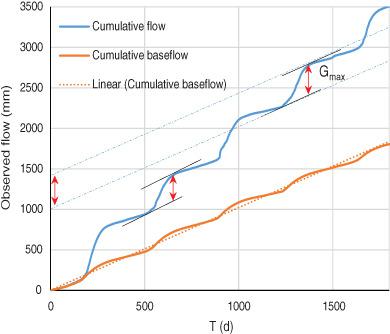当前位置:
X-MOL 学术
›
Hydrol. Process.
›
论文详情
Our official English website, www.x-mol.net, welcomes your feedback! (Note: you will need to create a separate account there.)
A parameter allocation approach for flow simulation using the WetSpa‐Python model
Hydrological Processes ( IF 3.2 ) Pub Date : 2020-11-24 , DOI: 10.1002/hyp.13992 Abdolreza Bahremand 1 , Sajad Ahmadyousefi 1 , Vahedberdi Sheikh 1 , Chooghi Bairam Komaki 1
Hydrological Processes ( IF 3.2 ) Pub Date : 2020-11-24 , DOI: 10.1002/hyp.13992 Abdolreza Bahremand 1 , Sajad Ahmadyousefi 1 , Vahedberdi Sheikh 1 , Chooghi Bairam Komaki 1
Affiliation

|
Hydrologic models are simplified representations of natural hydrologic systems. Since these models rely on assumptions and simplifications to capture some aspects of hydrological processes, calibration of parameters is unavoidable. However, utilizing the philosophy of a recent modelling framework proposed by Bahremand (2016), we show how calibration of most model parameters can be avoided by allocating or presetting these parameters utilizing knowledge gained from sensitivity analyses, field observations and a priori specifications as a part of a parameter allocation procedure. This paper details the simulation of daily river flow of the Shemshak‐Roudak watershed performed using the Python version of the WetSpa model. The WetSpa‐Python model is a distributed model of hydrological processes applied at the watershed scale. The model was applied to the Shemshak‐Roudak watershed of Iran with parameter allocation. Model calibration involved only two parameters. Straightforward methods were proposed for allocating model parameters, including three baseflow‐related parameters and the determination of maximum active groundwater storage using a mass curve technique. Also, the Budyko curve was used to constrain a correction factor for potential evapotranspiration. The WetSpa‐Python model was extended to include the influence of snowmelt. A failure to include snow in the hydrological processes of the WetSpa‐Python model creates a significant discrepancy between the observed and simulated hydrographs during the spring. The results of daily simulations for 12 years (2002–2014) are in good agreement with observations of discharge (Kling‐Gupta Efficiency = 0.84). These results demonstrate that it is feasible to simulate hydrographs with limited calibration given a knowledge of hydrological processes and an understanding of relationships between catchment characteristics and model parameters.
中文翻译:

使用WetSpa-Python模型进行流量模拟的参数分配方法
水文模型是自然水文系统的简化表示。由于这些模型依靠假设和简化来捕获水文过程的某些方面,因此参数的校准是不可避免的。然而,利用Bahremand(2016)提出的最新建模框架的理念,我们展示了如何利用灵敏度分析,现场观测和先验规格获得的知识来分配或预设这些参数,从而避免大多数模型参数的校准参数分配过程。本文详细介绍了使用WetSpa模型的Python版本对Shemshak-Roudak流域的每日河流流量进行的模拟。WetSpa-Python模型是在分水岭范围内应用的水文过程的分布式模型。该模型已应用于参数分配的伊朗Shemshak-Roudak流域。模型校准仅涉及两个参数。提出了简单的方法来分配模型参数,包括三个与基流相关的参数以及使用质量曲线技术确定最大有效地下水储量。此外,使用Budyko曲线来约束潜在蒸散量的校正因子。扩展了WetSpa-Python模型以包括融雪的影响。如果在WetSpa-Python模型的水文过程中没有包括积雪,则会在春季观测到的模拟水文图之间产生重大差异。12年(2002-2014年)的每日模拟结果与排放的观测结果非常吻合(Kling-Gupta效率= 0.84)。
更新日期:2021-01-19
中文翻译:

使用WetSpa-Python模型进行流量模拟的参数分配方法
水文模型是自然水文系统的简化表示。由于这些模型依靠假设和简化来捕获水文过程的某些方面,因此参数的校准是不可避免的。然而,利用Bahremand(2016)提出的最新建模框架的理念,我们展示了如何利用灵敏度分析,现场观测和先验规格获得的知识来分配或预设这些参数,从而避免大多数模型参数的校准参数分配过程。本文详细介绍了使用WetSpa模型的Python版本对Shemshak-Roudak流域的每日河流流量进行的模拟。WetSpa-Python模型是在分水岭范围内应用的水文过程的分布式模型。该模型已应用于参数分配的伊朗Shemshak-Roudak流域。模型校准仅涉及两个参数。提出了简单的方法来分配模型参数,包括三个与基流相关的参数以及使用质量曲线技术确定最大有效地下水储量。此外,使用Budyko曲线来约束潜在蒸散量的校正因子。扩展了WetSpa-Python模型以包括融雪的影响。如果在WetSpa-Python模型的水文过程中没有包括积雪,则会在春季观测到的模拟水文图之间产生重大差异。12年(2002-2014年)的每日模拟结果与排放的观测结果非常吻合(Kling-Gupta效率= 0.84)。


























 京公网安备 11010802027423号
京公网安备 11010802027423号